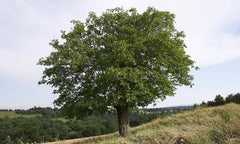The different oils in oil paint
Paint needs two parts in order to function as paint, pigment which is the colour and a medium in which that pigment is carried, this could be water, oil, resin or even egg which was used extensively pre 1600. The basic idea is the paint is applied and as the medium dries, evaporates or oxidises, the pigment is left bonded to the support, the support being canvas, paper, a wall, skin, etc.
This guide is about oil paint as the name suggests the medium is oil. Generally today most paints use linseed oil however this is not always the case and in fact not always the best in terms of results. We sell paints which use walnut oil, poppyseed oil and linseed, we also sell spike oil which is distilled from a lavender plant.
In theory any kind of oil which will dry could be used, a little sidestep here oil paint doesn't really dry it is a process of oxidisation where the oil mixes with oxygen in the air and changes chemically forming a solid but flexible layer, this is why oil paints without a siccative (drying agent) can take many months to 'dry', because it is not through evaporation but a chemical process.
Different oils all have different effects on the colour and the longevity of the dried paint film, the oils used need to be relatively clear, light in colour, stable and inert.
So what are the different types of oil and what are the differences between them?
The best known drying oil and most widely used is linseed oil, derived from the flax plant. The flax is one of several plants on the planet which grows easily and has an incredible amount of practical uses to the human race, hemp is another.

Flax plant in flower
Traditionally the oil would be cold pressed (the seeds crushed without heat) now it tends to be industrially produced using steam to extract more oil from the seed. This more modern process has been driven by economics and not for the benefit of the painter.
Cold pressed oil is generally agreed to be better in artists oil paints, giving the paint superior handling and feel, more importantly though supplying greater longevity with more flexibility in the paint film. The steam extracts more oil but it also extracts more impurities.
Interestingly as the production of linseed oil became a major industrial process, the availability of cold pressed oils decreased to practically zero and from around 1800 to 1930 oil paints tended to be made with steam pressed oils, fortunately market forces have resolved the situation and now high quality oil paints are generally made with cold pressed oil.
One issue is that any kind of linseed oil to some extent yellows with age.
The industrial way of reducing the yellowing is by bleaching the oil which leads to a much lighter coloured oil, it is also usually treated with sulphuric acid. However if cold pressed oil is properly aged and filtered it too can have a very light colour, again it comes down to buying the best quality you can afford.
I sometimes imagine how different a freshly painted Van Gogh would have looked, as the paintings have inevitably yellowed and lost some of their vibrancy and intenseness.

The poppy flower and seed head
The next oil I would like to 'dip' into is poppyseed oil, the paints we sell by Blockx are mostly ground in poppyseed oil except the iron oxides, earths and blacks where there would be an adverse reaction. The most noticeable difference in using poppyseed oil paint out of the tube is in the handling, it has a very satisfying creaminess not found in linseed oil paints.
If you were to compare refined linseed and poppyseed in two separate glass jars the immediate visible difference would be the colour, poppyseed oil even relatively unrefined is much lighter and practically clear compared to linseed. It also does not yellow in ageing.
Another property of poppyseed oil is it takes much longer to 'dry', this can be useful if you are painting 'wet into wet' (more about this later) or you want your paints to remain open (wet) for a long time. You can tell a poppyseed paint because of the lack of odour and where it really excels is in the whites, blues, yellows and the lighter hues on the palette because of it's clearer nature they are brighter than their linseed counterparts.
All these properties sound great so why not use poppyseed oil in all paint, well this is probably due to several factors, manufacturing paint is a business and poppyseed oil is more expensive to buy, although the small manufacturers we deal with all have masses of integrity and if they could make better paint with different oil they would. There is an argument that the dried film of poppyseed oil is not as strong or resilient as linseed due to the lesser amount of linolenic acid it contains.
Personally I think it comes down to the preferences of the manufacturer and the painter as all the drying oils used in oil paint have different natures, different pros and cons.
The next oil I would like to mention is Walnut Oil again naturally a very clear oil, it dries faster than poppyseed and it is felt to have an excellent refractive index for displaying pigments with the most possible vibrancy, it potentially can hold more pigment than linseed or poppyseed. Again though there is controversy over the longevity of the paint film. It is definitely the most expensive of the three, we sell a walnut oil white but generally it is not widely used. The exception is M.Graham a manufacturer in the USA who grind all their paint in walnut oil.

The English walnut tree
These are the three most widely used oils in good quality oil paint, and if you were to make your own paint they will sit happily with each other, so experimentation with different levels of each oil in a single paint is entirely possible to try and bring the best qualities of each to the mix.
There are other drying oils which could be used for paint, soya bean oil is widely used as an industrial alternative to linseed but is inferior to linseed and will not dry without siccatives. There is perilla oil from the East it is perfect except for its strong tendency to yellow and there are many other oils from this part of the world which are used industrially however often are not suitable for painting such as tung oil and lumbang oil.
Sunflower and hempseed oil have both been used successfully historically in Europe, however in more modern times have been found to be inferior to the other options.
The final oil I will mention is safflower oil, cultivated for centuries mainly for the dye from the blossoms, it has similar properties to linseed and is found in modern artists oils, I think though this is generally down to a cost decision rather than down to its outstanding properties as an oil for artist's paint, again there are some concerns about the paint film's longevity. It has a stunning flower though, pictured below.

Next I will move onto an introduction to pigments in artists oil paints.
